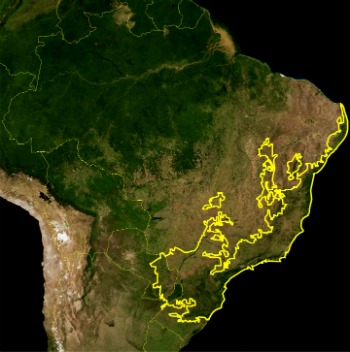The Atlantic Forest is a biome composed of a set of forests and ecosystems that corresponds to 15% of the Brazilian territory.
Since 1500, this area has suffered from deforestation, fires and environmental degradation.
That is why, currently, the vegetation corresponds to only 7% of the original forest, with medium and large trees, constituting a dense and closed forest .
Characteristics of the Atlantic Forest
Considered one of the richest biomes on the planet, that is, with greater biodiversity , the Atlantic Forest is the second largest forest in extension in Brazil , consisting of plateaus and mountains.
Its area covers the east, southeast and south of Brazil and, in addition, a part of Paraguay and Argentina.
Among the Brazilian states, it is present in 17 of them: Alagoas, Bahia, Ceará, Goiás, Mato Grosso do Sul, Minas Gerais, Paraíba, Paraná, Pernambuco, Piauí, Sergipe, Rio Grande do Norte, Rio Grande do Sul, São Paulo , Espírito Santo, Rio de Janeiro and Santa Catarina.
The forests that make up the Atlantic Forest are:
- Dense Ombrophilous Forest
- Open Ombrophilous Forest
- Mixed Ombrophilous Forest
- Seasonal Deciduous Forest
- Seasonal Semideciduous Forest
It also aggregates the following ecosystems :
- Mangroves
- Restingas
- Altitude Fields
Flora
According to data from the Ministry of the Environment, in the Atlantic Forest there are approximately 20,000 plant species corresponding to more than 35% of the species existing in Brazil.
Studies show a great diversity of trees per hectare, greater than that found in the Peruvian Amazon. This may represent the greatest diversity of trees per unit area in the world !

There are bromeliads, begonias, orchids, ipe, palm trees, lentils, rosewood, vines, bryophytes, rosewood, peroba, jambo, jequitibá rosa, imbaúba, cedar, tapiriria, andira, pineapples and fig trees.
According to current research, 200 Brazilian plant species are threatened with extinction, 117 of which belong to this biome.
Fauna
In the same way, the fauna is very rich. According to studies carried out, the Atlantic Forest is home to 849 species of birds, 370 species of amphibians, 200 species of reptiles, 270 species of mammals and about 350 species of fish .
Many of these animals are at risk of extinction: golden lion tamarin , howler monkey, giant anteater, deer, opossum, agouti, giant armadillo, mono-carvoeiro, macaw , otter, coati, tapir, jaguar , ocelot, capybara, etc.
Climate
The climate of the Atlantic Forest is predominantly humid tropical , influenced by the humid air masses coming from the Atlantic Ocean.
It also presents other microclimates along the forest, since the large trees that make up the vegetation generate shade and humidity.
In addition to the humid tropical coastal climate, present in the northeastern region, the Atlantic Forest also encompasses the tropical climates of altitude , in the southeast region, and the humid subtropical , in the south region.
Its average temperatures and air humidity are high throughout the year and the rains are regular and well distributed.
Population
It is important to highlight that in the region of the Atlantic Forest approximately 70% of the Brazilian population lives , which represents more than 120 million people.
As well as natural diversity, there is great cultural diversity and traditional peoples.
These communities are indigenous , the quilombos, the native population and riverside communities who live a deep relationship with nature.
Depending on it for their subsistence, they use their resources in a sustainable way for food, for handicrafts, among other purposes.

